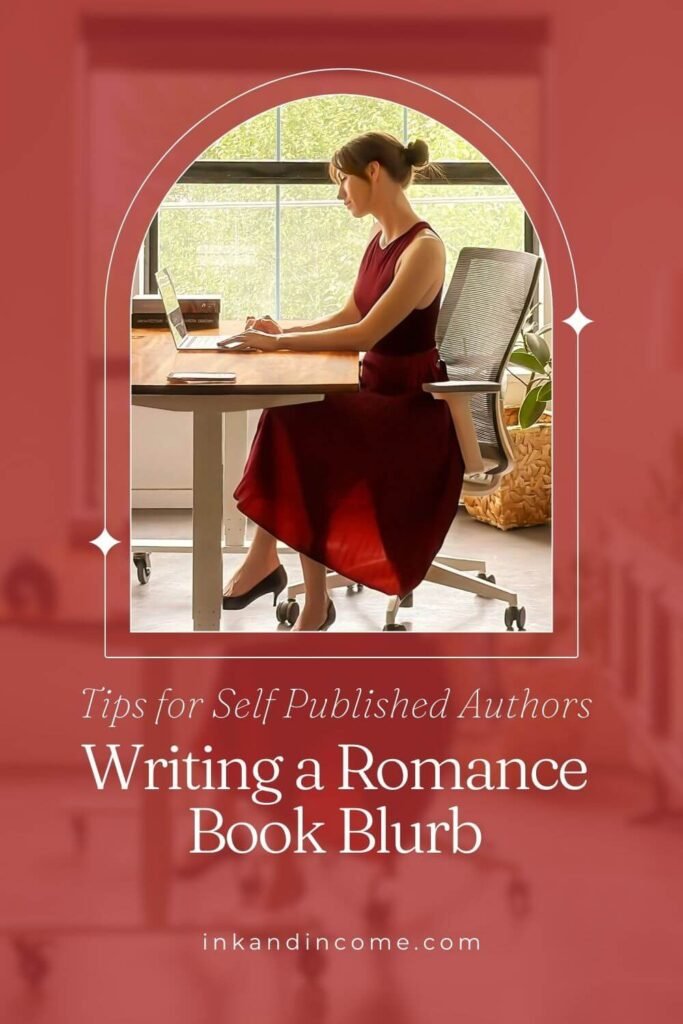
Your book’s cover makes the first impression, but your book description might end up being the difference between a browser and a buyer.
A good book blurb doesn’t summarize your story. It seduces potential readers—getting them curious and convincing them that your romance novel is worth their time and money.
Getting the book description right isn’t optional—it’s essential. So, let’s learn about crafting ones that’ll capture hearts and drive sales.
What Makes a Romance Book Blurb Great?
Let’s start by understanding the 4 essential elements that make romance book blurbs irresistible:
- A captivating hook that grabs attention immediately
- Emotional appeal that resonates with romance readers
- Character-focused storytelling that creates instant connection
- Clear stakes and conflicts that promise an engaging journey
Why don’t we break it down into steps?
Step-by-Step Guide to Writing Your Romance Book Blurb
Step 1: Know Your Reader
Before writing a single word, you’ve gotta understand exactly who your readers are. Who are they? What they’re seeking in a romance novel? Romance readers are usually looking for:
- Strong emotional connections between characters
- Captivating relationships with authentic chemistry
- Specific genre expectations (like happily-ever-after endings)
- Familiar tropes they love (enemies-to-lovers, second-chance romance, etc.)
So, ask yourself:
- Who exactly am I writing this book for?
- What emotional experience do my ideal readers expect?
- What genre or sub-genre conventions should I signal?
Understanding your audience helps you speak to them. It makes your blurb more effective.
Step 2: Start with a Hook
Your opening line should capture your reader’s attention immediately. This hook is your first (and sometimes only) chance to make an impression.
Look at how Ana Huang begins the blurb for King of Wrath:
“She’s the wife he never wanted… and the weakness he never saw coming.”
We understand the central conflict and emotional stakes in one line. It’s an arranged marriage situation with unexpected feelings developing.
Some other effective hook techniques include:
- Posing a compelling question or dilemma
- Highlighting an emotionally charged scenario
- Teasing a unique character situation
Your hook should make readers think, “I’ve gotta know more about this story.”
Step 3: Introduce Your Main Characters
After your hook, introduce your protagonists in a clear and compelling way. In romance, readers are often more invested in the characters than the plot.
Consider how Danielle Lori introduces her protagonist Elena in The Sweetest Oblivion:
“Nicknamed Sweet Abelli for her docile nature, Elena smiles on cue and has a charming response for everything. She’s the favored daughter, the perfect mafia principessa… or was. Now, all she can see in the mirror’s reflection is blood staining her hands like crimson paint.”
What does this introduction do? It:
- Creates immediate intrigue about Elena’s character
- Sets up a contrast between her public image and inner reality
- Suggests a compelling character arc
When introducing your characters:
- Focus on their most compelling traits or internal struggles
- Provide enough detail to intrigue without overwhelming
- Emphasize the qualities that will make readers emotionally invest in their journey
Step 4: Establish Stakes and Conflict
What do your characters stand to lose or gain? In romance, emotional stakes reign supreme. They’re essential to building reader interest.
H.D. Carlton’s Haunting Adeline blurb demonstrates this:
“Parson’s Manor now holds more than just Adeline’s memories—it houses a grim future that could lead to history repeating itself. If she doesn’t fall in love with her stalker first.”
What does this establish?
- The primary danger (potential murder like her great-grandmother)
- The twisted emotional complication (falling for her stalker)
- The impossible situation the protagonist finds herself in
When establishing your stakes:
- State what your protagonists want and why it matters clearly
- Present the key obstacle preventing their happiness
- Emphasize emotional and relationship stakes rather than plot mechanics
Step 5: Set the Tone and Promise a Reward
Your blurb should convey your romance sub-genre’s tone.
Is your story sweet and heartwarming? Is it darkly passionate? Is it comedic? Your readers need to know what emotional experience to expect.
Let’s look at Kate Spencer’s In a New York Minute blurb. It establishes its light, contemporary rom-com feel perfectly:
“Franny Doyle is having the worst day. She’s been laid off from her (admittedly mediocre) job, the subway doors ripped her favorite silk dress to ruins, and now she’s flashed her unmentionables to half of lower Manhattan.”
The humorous tone and modern setting immediately let you know what kind of romance to expect.
Your tone-setting should:
- Match your book’s actual content and style
- Appeal to your target audience’s preferences
- Suggest the emotional journey readers will experience
Step 6: Create an Enticing Hook Ending
End your blurb with a strong statement or question that encourages immediate action.
Look at how Pippa Grant’s The Last Eligible Bachelor blurb concludes:
“But you know what they say about fake-dating a billionaire: It’s all fun and games, until the scandals start.”
What does this ending do? It:
- Creates curiosity about what scandals will unfold
- Implies a transformation in their relationship
- Leaves readers wanting to know what happens next
Your closing hook should:
- Create a sense of urgency or curiosity
- Hint at complications without revealing solutions
- Make it almost impossible not to click “buy” or “read more”
Common Mistakes and How to Avoid Them
Even experienced authors can make these common mistakes when writing their book descriptions.
Revealing Too Much
Your book blurb shouldn’t summarize. It should entice. Avoid giving away key plot twists, crucial turning points, or resolutions. Maintain the mystery to keep readers curious.
Excessive Plot Details
Focus on the emotional experiences and character-driven conflicts rather than specific plot details. Romance readers want to know how the story will make them feel, not every event that occurs.
Lack of Emotional Appeal
Always highlight the emotional stakes vividly. Make it easy for readers to connect with the characters’ struggles and desires. This emotional connection is what sells romance novels.
Neglecting Tone
Make sure your book blurb matches the emotional tone of your book. For example, a steamy romance with a blurb that reads like a sweet, clean romance will disappoint readers—and lead to negative reviews.
Wordiness and Lack of Clarity
Aim for a length of about 150-200 words. Avoid overly complex sentences, unnecessary adjectives, or vague descriptions. Each word should serve a clear purpose.
Final Tips for Self-Published Authors
- Study Bestsellers in Your Sub-Genre: Analyze what makes their blurbs effective and use those techniques.
- Test Multiple Versions: Consider creating 2-3 different blurbs. See which performs better with your audience.
- Identify Your Genre Clearly: In other words, don’t make readers guess if your book is contemporary romance, paranormal romance, or romantic suspense.
- Make the HEA (Happily Ever After) or HFN (Happy For Now) Implicit: Romance readers expect a satisfying conclusion—hint at it without spelling it out.
- Use Relevant Keywords: Keep your blurb natural and engaging, while including the right keywords for discoverability.
Putting It All Together
A well-crafted book blurb is a powerful tool in your self-publishing journey. It converts a browser to a buyer—transforming casual interest into sales and loyalty.
Your book description is often the first impression potential readers have of your writing. It should read in your voice, hint at your style, and demonstrate that you understand the romance genre and its readers.
By following these steps and avoiding common pitfalls, you’ll write a book blurb that captures attention. This will give your romance novel the best chance of succeeding in today’s competitive publishing landscape.
Whether you’re publishing your first romance novel or your fiftieth, these principles will help you craft book descriptions that connect with readers and drive your book marketing success.



